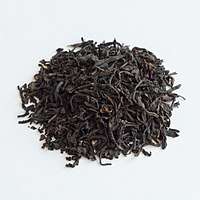Lapsang souchong
| Lapsang souchong | |||||||||||||
|---|---|---|---|---|---|---|---|---|---|---|---|---|---|
 | |||||||||||||
| Type | Black | ||||||||||||
|
| |||||||||||||
| Origin | Mount Wuyi, Fujian Province, China | ||||||||||||
|
| |||||||||||||
| Quick description | Souchong smoked over pine fire, smoky taste. | ||||||||||||
|
| |||||||||||||
| Temperature | boiling water (100°C or 212 F) | ||||||||||||
| Time | 2–3 minutes | ||||||||||||
| Chinese name | |||||||||||||
| Traditional Chinese | 立山小種 | ||||||||||||
| Simplified Chinese | 立山小种 | ||||||||||||
| Literal meaning | “Coarse tea leaves from Li Mountain” | ||||||||||||
| |||||||||||||
| Alternative Chinese name | |||||||||||||
| Traditional Chinese | 正山小種 | ||||||||||||
| Simplified Chinese | 正山小种 | ||||||||||||
| |||||||||||||
Lapsang souchong (/ˌlæpsæŋ
Xiǎozhǒng or Siu2 zung2 (小种 / 小種) refers to the larger, coarser tea leaves lower on the branch. Lapsang souchong is a member of the Bohea family of teas though not an Oolong, as are most Bohea teas ("Bohea" is the pronunciation in Minnan dialect for Wuyi Mountains, which is the mountain area producing a large family of tea in South-East China).
Lapsang souchong from the original source is increasingly expensive, as Wuyi is a small area and there is increasing demand for this variety of tea.
History
The story goes that the tea was created during the Qing era when the passage of armies delayed the annual drying of the tea leaves in the Wuyi Mountain. Eager to satisfy demand, the tea producers sped up the process by drying the leaves over fires made from local pines.
According to some sources, Lapsang souchong is the first black tea in history, even earlier than Keemun tea. After the lapsang souchong tea was used for producing black tea called Min Hong (meaning "Black tea produced in Fujian"), people started to move the tea bush to different places, such as Keemun, India and Ceylon.
Processing
“Souchong” (小种) refers to the fourth and fifth leaves of the tea plant, further away from the more highly prized bud (pekoe) of the tea plant. These leaves are coarser than the leaves closer to the bud and have fewer aromatic compounds. Smoking provides a way to create a marketable product from these less desirable leaves.[2]
The leaves are roasted in a bamboo basket called a hōnglóng (烘笼), which is heated over burning firewood, which contributes to the dried longan aroma and smoky flavour.[3] Pinewood is used as the firewood for lapsang souchong and imparts the characteristic resiny aroma and taste.
Chemistry
The aroma of lapsang souchong is derived from a variety of chemical compounds. The two most abundant constituents of the aroma are longifolene and α-terpineol. Many of the compounds making up the aroma of lapsang souchong, including longifolene, originate only in the pine smoke and are not found in other kinds of tea.[4]
Flavor and aroma

Lapsang souchong is noted for its rich aromas and flavors which include pine resin, woodsmoke, smoked paprika, hints of dried longan,[5][6] and the evocation of peated whiskey.[7]
It is common for even rather strongly brewed Lapsang Souchong tea to lack the bitterness common with other tea varieties.
Reputation
Lapsang souchong has a high reputation outside China; it is viewed as "tea for Westerners" inside China. It was drunk by Winston Churchill[8] and Gary Snyder,[9] who referred to it in Mountains and Rivers Without End.
In popular culture
- When told that his Captain Picard character from Star Trek: The Next Generation would drink a lot of tea, Sir Patrick Stewart originally suggested that he drink Lapsang souchong, but the producers were afraid the audience wouldn't know what that was, so the character drank Earl Grey tea instead.[10]
- In the movie Phantom Thread, Daniel Day Lewis' character orders a pot of Lapsang souchong tea at a hotel restaurant.[11]
- In the movie Casino Royale, David Niven's character orders a pot of jasmine tea from his assistant, which he clarifies as Lapsang souchong. [12]
- In the book The Goldfinch by Donna Tartt, the main character, Theo, is served Lapsang souchong tea by Hobie, a cabinetmaker.
See also
References
- ↑ "Smoked Tea". silvertipstea.com. Retrieved 2012-07-09.
- ↑ Delmas, F. X.; Minet, M.; Barbaste, C. (2008). The Tea Drinkers Handbook. Abbeville Press. pp. 49, 159. ISBN 978-0-7892-0988-7.
- ↑ "Lapsang Souchong Tea". Tea and Coffee. The Kent and Sussex Tea and Coffee Company. 21 September 2016. Retrieved 20 May 2017.
- ↑ Yao, S. S.; Guo, W. F.; Lu, Y.; Jiang, Y. X. (2005). "Flavor Characteristics of Lapsang Souchong and Smoked Lapsang Souchong, a Special Chinese Black Tea with Pine Smoking Process". Journal of Agricultural and Food Chemistry. 53 (22): 8688–93. doi:10.1021/jf058059i. PMID 16248572.
- ↑ "Lapsang Souchong Tea". www.flavorandfortune.com. Retrieved 2018-03-16.
- ↑ "Lapsang Souchong Tea - Smoked Chinese Black Tea". Retrieved 2018-05-31.
- ↑ Perry, S. (2010). Tea Deck: 50 Ways to Prepare, Serve, and Enjoy. Chronicle Books. p. 24. ISBN 978-0-8118-7288-1.
- ↑ Heiss, M. L.; Heiss, R. J. (2011). The Story of Tea: A Cultural History and Drinking Guide. Ten Speed. p. 133. ISBN 978-1-6077-4172-5.
- ↑ http://www.millvalleylit.com/literarylatte.html
- ↑ Mitchell, Ben (September 1998). "Patrick Stewart - Beavis and Butt-head's biggest fan on theft, tea and Tetris". Neon (UK Film Magazine). UK: EMAP. Retrieved 7 July 2017.
- ↑ Lane, Anthony (January 2018). "The Claustrophobic Elegance of "Phantom Thread"". The New Yorker. USA: Condé Nast. Retrieved 26 February 2018.
- ↑ Template:Cite movie Casino Royale (1967 film)
External links
| Look up lapsang souchong in Wiktionary, the free dictionary. |
| Wikimedia Commons has media related to Lapsang souchong. |